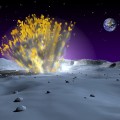This illustration is from a portfolio of hand-tinted lithographs purported to illustrate the “discovery of life on the moon.” In 1835, Richard A. Locke, writing for the New York Sun, claimed that the noted British astronomer Sir John Herschel had discovered life on the moon. Flora and fauna included bat-men, moon maidens (with luna-moth wings), moon bison and other outlandish life forms. Locke proposed an expedition to the moon using a ship supported by hydrogen balloons.
You can see this image and others in the Smithsonian Libraries’ exhibition “Fantastic Worlds: Science and Fiction, 1780–1910” on display in the Smithsonian’s National Museum of American History through October 2016.
“Fantastic Worlds” explores the intersection of science and fiction in the years between 1780 and 1910—a time of major inventions and achievements in engineering: railways, the telegraph and the precursor to the modern computer. Explorers were reaching the last uncharted corners of the Earth, and new ideas about mankind the history of the planet and the heavens above were emerging. Scientific disciplines came into their own, such as geology and the study of the deep sea, and experiment, invention and discovery were hallmarks of the era; they altered forever how people live and how they see themselves and the world around them.
These often astonishing discoveries and inventions found their way into fantastic fictional worlds, as writers creatively explored the furthest reaches of the new scientific landscape, using imagination to craft hoaxes, satires and fictional tales.
Explore “Fantastic Worlds” here.






